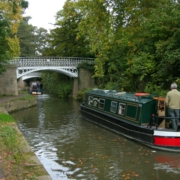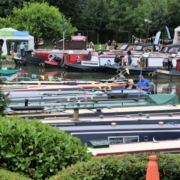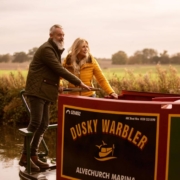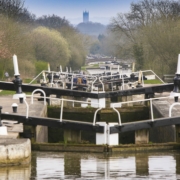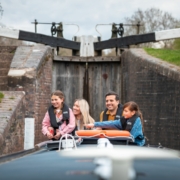Quirky Canals
Britain’s 2,000-mile long and 200-year old canal network is a treasure trove of historic structures, many of them quirky and unorthodox. It’s also a haven for wildlife, but not always what you might expect.
To celebrate the rich tapestry of canal history and habitat, we’ve put together our Top 10 Quirky Canal Facts:
- Terrapins – red-eared terrapins are now a common sight on England’s waterways, largely as a result of the Teenage Mutant Ninja Hero Turtles cartoon craze which began in the 1980’s. Imported from the USA to be sold as pets, these terrapins can grow to the size of a dinner plate, making them less appealing and difficult to manage. Consequently, they are often irresponsibly released into the wild and can be seen basking on dry land during sunny days. At the moment it looks unlikely that they are breeding as terrapin eggs need to be incubated at 25 degrees Celsius for 60 days in order to hatch, but climate change may enable them to increase their numbers and potentially harm native animals.
- Lock cottages with barrel shaped roofs – the quirky lock cottages of the Stratford Canal have unusual barrel shaped roofs. It’s believed the canal builders chose this unusual style the mimic the shape of the canal bridges.
- Pill boxes along the K&A – visitors to the Kennet & Avon Canal, which connects the River Thames at Reading with the Bristol Avon at Bath, will notice a large number of pill boxes lining the waterway. Designed by the War Office, these fortifications were commissioned by General Sir Edmund Ironside, following the British Expeditionary Forces’ evacuation from Dunkirk, and the prospect of imminent German invasion. Named GHQ Stop Line Blue, the canal was equipped to be a static defence line, with the pill boxes and trank traps manned by the Home Guard. Some, including one at Garston Lock near Reading, have now been adapted to create homes for bats!
- Zebra mussels in the locks – these stripy little freshwater mussels originally arrived in Britain on the hulls of ships from Eastern Europe. They grow up to 5cm long and rapidly form large colonies, attaching themselves to almost any submerged hard surface, including lock gates and sluices.
- The Anderton Boat Lift – also known as the ‘Cathedral of the Canals’, this fascinating example of Victorian engineering, which looks like a giant iron spider perched on a hilltop, provides a 15-metre vertical link between the Trent & Mersey Canal and River Weaver Navigation. Designed by Edwin Clark and opened in 1875, it consists of two caissons, each large enough to take a barge or pair of narrowboats.
- The Roundhouse in Birmingham – this unique horseshoe shaped canal building in Birmingham City Centre is being transformed into a place to work, socialise and rest. The Grade II* listed building on the Birmingham Mainline Canal in the centre of Birmingham, dates back to 1874 and originally provided stables and stores for the Birmingham corporation.
- Snowdon’s Aviary at London Zoo – from Little Venice, where the Grand Union Canal meets the Regent’s Canal in London, the London Waterbus operates trip boats which take people along the Regent’s Canal and into London Zoo via a special waterside entrance. Along the way, boaters pass beneath Snowdon’s iconic Aviary constructed alongside the canal in 1964. The Aviary is currently being transformed into a stunning walkthrough exhibit.
- Green canals – when summer temperatures soar, thick carpets of bright green duck weed can appear along sections of Britain’s canals, especially in London. While an individual piece of duck weed is no bigger than a ladybird, when they multiply into large numbers, they clog up canals, starving the water of oxygen and sunlight, and causing problems for some wildlife. In the right conditions, a mass of duck weed can double in size every two or three days.
- The ghostly Blisworth Tunnel – on the Grand Union Canal at Stoke Bruerne in Northamptonshire, the 2,795-metre long Blisworth Tunnel has spooked a number of boaters over the years. When construction began in 1793, the tunnel was a major engineering challenge. Teams of navvies worked with picks and shovels for three years until they hit quicksand and the tunnel collapsed, killing 14 men. A new route for the tunnel was found and it finally opened on 25 March 1805. But over the years, a number of boaters travelling through the tunnel have reported seeing lights and a second ghostly route emerging…
- The Foxton Inclined Plane Boat Lift – this extraordinary feet of Victorian engineering once operated next to Foxton Locks. Two counterbalanced caissons (giant bathtubs) that could each hold two narrowboats or one wide-beam barge, were built to slide up or down the hill on tracks. They enabled boats to make the journey in just 12 minutes – nearly six times quicker than going through the locks. Opened in 1900, sadly it was never a commercial success due to decreasing canal traffic and the fact that the Watford flight was never widened to take larger boats. The plane was mothballed in 1911 and dismantled for scrap in 1928.


